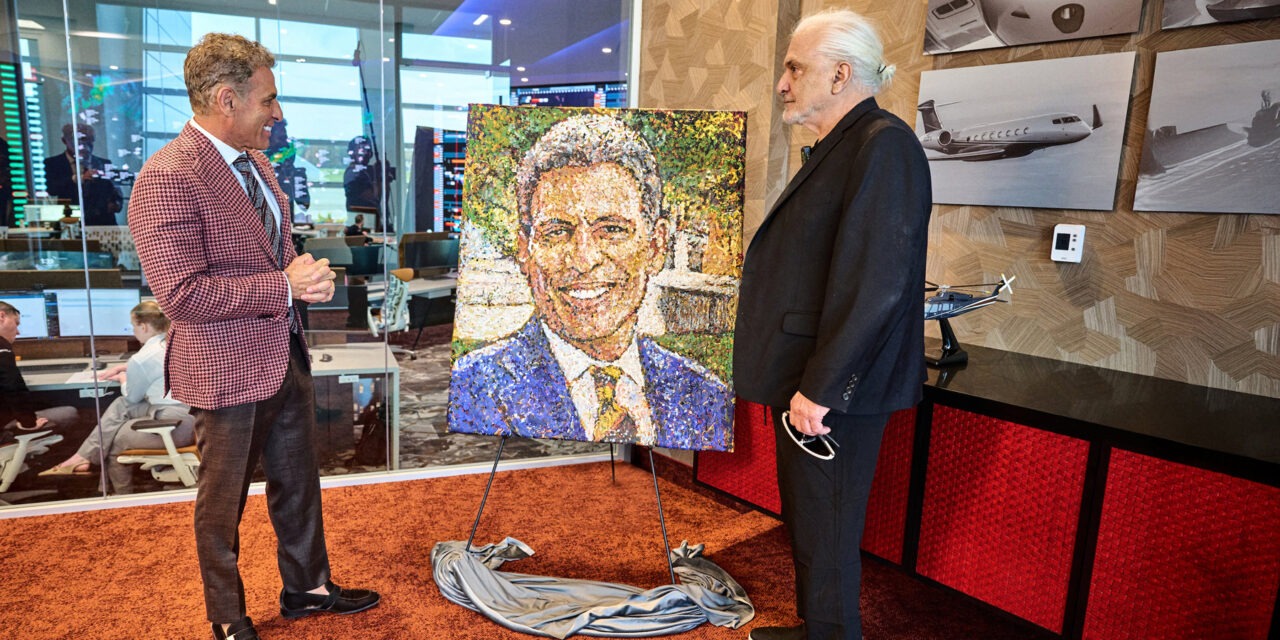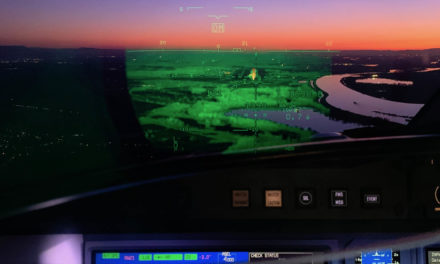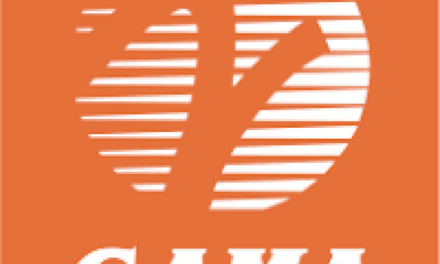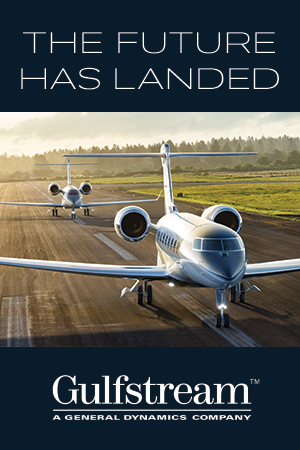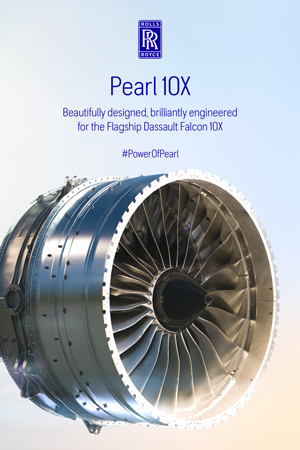By Sylvie Peron – © Flexjet
Kenn Ricci is the Principal of Directional Aviation, based in Cleveland, Ohio, USA. Flexjet, the largest company in the group and its flagship, is also Ricci’s favorite business as it is both “challenging and stimulating, with a sense of romance about it”. Launched in 1995, Flexjet was founded at the dawn of the shared ownership aircraft industry by Bombardier Aerospace Group and AMR Corp (the parent company of American Airlines) as one of the first shared ownership operators. Directional Aviation, led by visionary entrepreneur Kenn Ricci, acquired Flexjet in 2013.
In November 2024, American artist Giovanni De Cunto, who is known for his unique take on modern art, presented a portrait painting to Kenn Ricci, at Flexjet’s new state-of-the-art global headquarters in Cleveland, Ohio. This futuristic $50 million building houses the company’s Global Operations Center and private aviation’s largest seamless LED display in the US. The painting had been specially commissioned by the magazine. Upon its delivery, one of the industry’s most respected leaders, Flexjet Chairman and Directional Aviation Capital Principal Kenn Ricci took the time to talk to Ultimate Jet.
Ultimate Jet – What drew you to aviation?
Well first of all, my father ran the Cleveland National Air Races. Growing up I would have odd jobs, and as a teenager I would be around the air show. That was my first exposure. At that time the performers were the Blue Angels. As part of my job, I would drive them to and from their hotels and so I got to be around this kind of wonderful group of aviators. People talked airplanes all the time. However, I didn’t think I would have a career in aviation, that wasn’t my goal.
When I got admitted to Notre Dame I remember hearing my parents discussing how they would have to tell me that they couldn’t afford to send me there. My father worked for the US government, which wasn’t the most lucrative job. When I was visiting on campus the following week, I inquired if there was any financial aid available or scholarships because I realized all of the sudden, I wasn’t going to be able to go without financial assistance. I was told that I was kind of late in the program but there was this ROTC program. The Vietnam War was just ending at that time. The military was very unpopular and they were not meeting their quotas for cadets.
I went to the Naval office. It was a Saturday and the ROTC was closed but you could walk through the corridors. I was peeking in the Navy ROTC office to try to get the phone number. As I’m standing there, a guy taps me on the shoulder and says, «Can I help you?» I told him I was an incoming freshman as I’d been admitted and was interested in going into ROTC. And I’d like to fly jets. «Are you sure you have been admitted?» he answered. «Because you are a little confused! See, the Navy has ships and the Air Force has jets.» Then he told me he was the head of the Air Force program here. Next thing you know, we are in his office, and I am joining the Air Force ROTC program.
UJ – How did you go from a corporate pilot with thousands of hours of experience to starting your first business?
There are two types of businessmen. The first kind, are businesspeople who love business. They are transactional, they like the transaction. Then there are people who get passionate about the business they are in. That was my background. I loved business and I got to love aviation. Back in the 80s – that’s when most of my flying career happened – private aviation was in its infancy and a tenth of the size it is today. There were less than 5,000 jets at the time, the airlines were furloughing at will. Aviation jobs and the aviation industry were just not that stable. It occurred to me that if I wanted to have some stability in aviation, I would have to start a company on my own and have some control over its success or failure. I remember distinctly the minute when I decided to start my first company. In the late 80s before the existence of GPS, I was flying international as a pilot for Virgin’s Richard Branson.
We would use INS (Inertial Navigation Systems) for long-range navigation. These units were very complex and there was a duopoly at the time, with Delco and Litton controlling the majority of the INS systems. I broke down in Paris and couldn’t get the INS to come online – so that meant you couldn’t cross the Atlantic without long-range navigation. I was faced with cancelling the trip or paying an exorbitant amount to get a loaner unit, followed by an exchange, which amounted to over a $60K bill. I realized there must be margin in this. So, I investigated repairing these INS units and then started a company, called Inertial to repair long-range navigation systems, which I sold – to HEICO in the late 90s. So, being immersed in the industry allowed me to identify an opportunity. This is still how I think about identifying opportunities today.
UJ – What would you attribute your success in private aviation to?
As an investor, I always say, «We are an inch wide and a mile deep.» In other words, only focusing on a narrow range of investments we understand and that relate to other companies we own. We try to draft off of these other investments, like how aircraft training can draft off of aircraft operations. As it relates to Flexjet, which is our largest company and the flagship, certainly the biggest challenge is the high capital cost of building this type of company. And if there was one thing that we did differently than our competitors who didn’t survive, it was that we paid a lot of attention to the balance sheet. Aviation is so capital intensive that if you don’t have a balance sheet plan, it’s tough to have that long-term stability. Flexjet today is a $4 billion company and the balance sheet is tremendously important – from buying new aircraft, growing our leasing program and expanding internationally. Early on that was much more challenging than it is today. Many people start companies with a path to profitability and a focus on the income statement. But when you operate aircraft, expensive aircraft, you need to solve the capital issue first – then profitability. Too many companies do it the other way around.

UJ – You’ve previously mentioned that as an entrepreneur, only the paranoid survive. What do you mean by that?
If you are really immersed in your business, foreseeability is tremendously important – being tuned in to what are the challenges that could come to harm you in the future.
For example, going back to three years ago, Directional owned a substantial maintenance company called Constant Aviation. Significant investors – both manufacturers and private equity kept approaching us, interested in buying that company for tremendous value. About 30 percent of the volume for that company was Flexjet and about 70 percent was other people. If we sold that company, where would Flexjet go to get its maintenance? And we began to see the funnel narrowing for options that Flexjet would have for maintenance. We could certainly foresee that as investors in maintenance companies combine smaller operators and looked for a return on their investment, prices would go up, as access would diminish. All of this would be extremely detrimental to Flexjet. Maintenance is the backbone of fleet availability, which is the backbone of cost control. So being paranoid about how these maintenance costs long-term could harm us drove the decision to bring all of our maintenance in-house. At all of our goal reviews we always focus on what are the foreseeable threats and have a reaction plan if they come to fruition.
UJ – What’s the best business advice you ever received?
Think long term. When you are starting a business, it is not always easy to take a short-term loss to create a long-term benefit. But doing the right thing for customers, employees and vendors will create immense advantages, because it creates a reputation or a cultural identification. Culture beats strategy every time. The advice I give to my children is to be passionate about what you do and compassionate about how you do it.
UJ – What is your favorite airplane?
The answer is obvious – it’s the next one I’m going to buy. But I have the majority of my flying hours in Gulfstream aircraft and I’m comfortable in them. I flew a G2 and G3 throughout Africa in the 1990s when the support and infrastructure were not what they are today. But the aircraft never let me down. This is still the case at Flexjet where we now operate over 60 Gulfstreams. I obviously have an affinity for them – I bought my first G4 in 2007 and have owned a G5, G650 and just recently bought a G700.
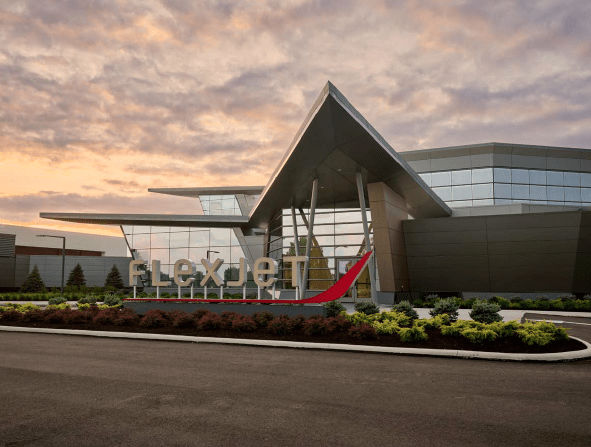
UJ – Which of your businesses is your favorite?
Without a doubt – I would tell you Flexjet is my favorite business because it is so interesting. It is always challenging, stimulating and it has a sense of romance about it. The employees are passionate and excited to be there. Pilots are getting to fulfill, in many cases, their lifelong dream of traveling and flying. And the customers that I get to be involved with are extraordinarily accomplished and successful individuals who are a delight to be around. It is truly an elite Country Club atmosphere. We hold a Chairman’s Event once a year where we invite our customers to come to a private curated event and they love to come because they love to hear about aircraft and connect with other customers.
And no matter what your business is – if I call you to talk about airplanes, you always take my call because people like to talk about aviation. People love airplanes. I like the business because it makes it so accessible and easy to meet people.
Kenn Ricci is recognized as a leader and innovator in the private aviation industry and you can follow him on Instagram @kennricci

